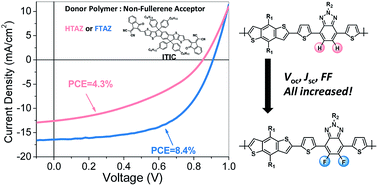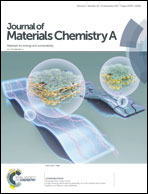Donor polymer fluorination doubles the efficiency in non-fullerene organic photovoltaics†
Abstract
Donor polymer fluorination has proven to be an effective method to improve the power conversion efficiency of fullerene-based polymer solar cells (PSCs). However, this fluorine effect has not been well-studied in systems containing new, non-fullerene acceptors (NFAs). Here, we investigate the impact of donor polymer fluorination in NFA-based solar cells by fabricating devices with either a fluorinated conjugated polymer (FTAZ) or its non-fluorinated counterpart (HTAZ) as the donor polymer and a small molecule NFA (ITIC) as the acceptor. We found that, similar to fullerene-based devices, fluorination leads to an increased open circuit voltage (Voc) from the lowered HOMO level and improved fill factor (FF) from the higher charge carrier mobility. More importantly, donor polymer fluorination in this NFA-based system also led to a large increase in short circuit current (Jsc), which stems from the improved charge transport and extraction in the fluorinated device. This study demonstrates that fluorination is also advantageous in NFA-based PSCs and may improve performance to a higher extent than in fullerene-based PSCs. In the context of other recent reports on demonstrating higher photovoltaic device efficiencies with fluorinated materials, fluorination appears to be a valuable strategy in the design and synthesis of future donors and acceptors for PSCs.

- This article is part of the themed collection: 2017 Journal of Materials Chemistry A HOT Papers


 Please wait while we load your content...
Please wait while we load your content...